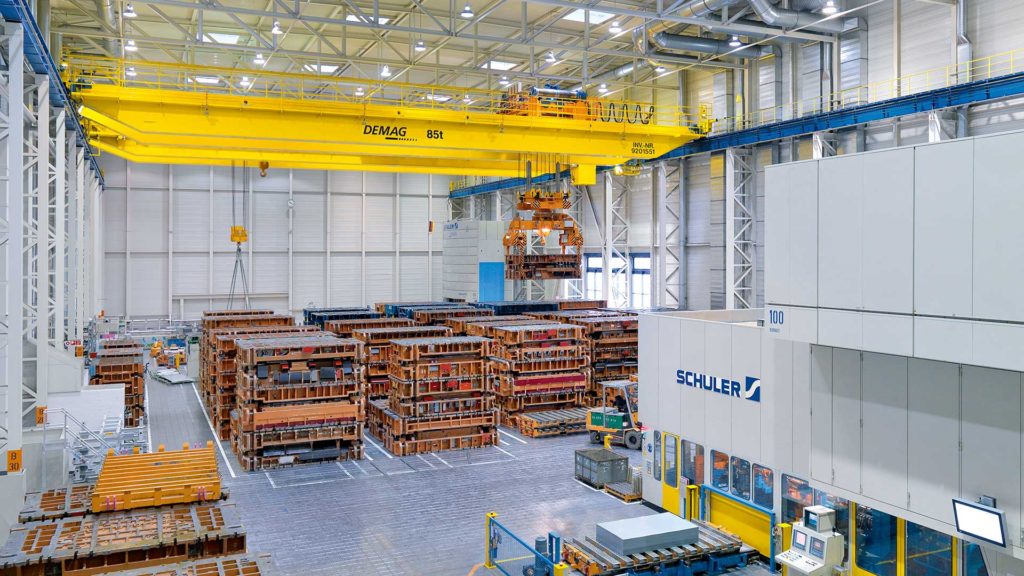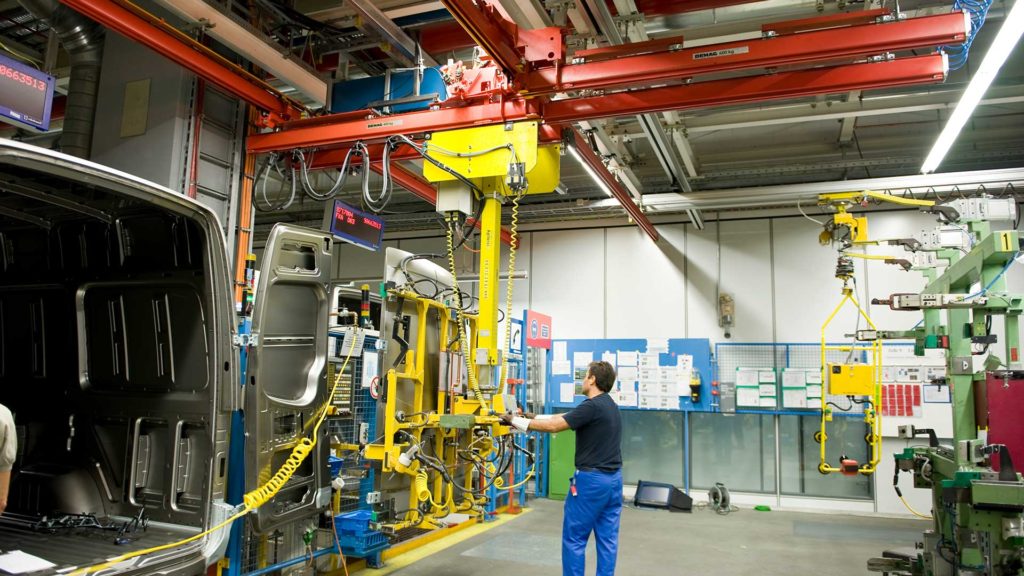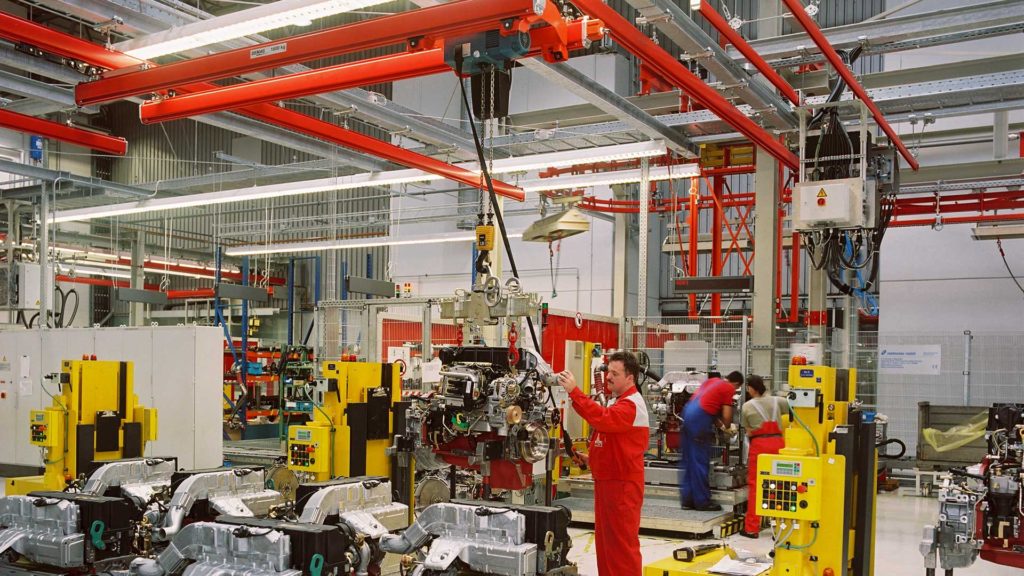With every economic upturn or downturn, you always hear about the auto industry. Even with the COVID climate we are living through today, the auto industry is talked about for good reason. The US is the second largest market for vehicle sales and production, and all major auto manufacturers have production facilities set up in the country. This reach extends further to engine and transmission plants, R&D development1, and 4.26 million jobs2 extending into dealer networks and manufacturers fed by vehicle production. It’s a similar story in Canada. Canada is the 10th largest market for vehicle production, contributing $20 CAD billion to its GDP and supporting an estimated 500,000 jobs.3 In addition to the OEM aspect, there is a $46 billion market in the aftermarket, producing goods large and small to support the tight-knit network of car enthusiasts out there.4
When it comes to supporting the automotive market with lifting and materials flow products, the possibilities are wide. Whether the support is needed for lifting many tons or moving a light load, the cranes and tools available are matched to the job. In this post, we will go through many of the common cranes and workstations that support the automotive industry. These cranes and workstations are specifically designed to meet the needs and demands of the workforce and production capabilities.
Heavy Lifting

Cranes for Die Handling
Die handling cranes are demanding in all industries. Not only do they need to lift heavy loads, but they may also need to perform complex turns and maneuvers during the process. Die handling cranes do a variety of jobs including automatically positioning, storing and retrieval of dies and managing parts of the process.
When an automotive manufacturer is casting a large piece, like a car frame, the dies used are very large. The cranes can grip the die with a special below the hook attachment specifically made to grip it on all 4 corners. When turning maneuvers are needed, the die can be handled using ropes on 2 of the sides or all 4 corners. When lifting a heavy load like a die, these can be single or double girder cranes with wire rope hoists to do the lifting. In addition, die handling cranes are packed with advanced positioning and safety features like anti-sway, anti-snag, off-center pick protection, and no-fly zones to meet specific needs for each facility.

Material Flow Cranes to Support Heavy Loads
We have all seen the photos and videos online of the assembly lines of vehicle manufacturers used to build an entire car. The car chassis moves down the line, supported from the ceiling, and the various parts and components being added by the workforce. It’s a fascinating process to watch. This is a great example that shows how a crane and crane component help with material flow through a plant.
When the car chassis is part of the material flow, the hoist or structure supporting it must be able to support the weight of the load full built. When you think about the weight of a car, this means you need to support multiple tons of weight throughout a process. Our Demag DH wire rope hoist has been a part of these types of systems, working with another below the hook attachment to support the car chassis.
Light Lifting and Workstation Cranes
Nearly any production process has a lifting aspect to it. Whether lifting can be completed manually or with the assistance of a chain hoist, the most important parts of the process are keeping operators safe and improving ergonomics. Putting measures in place like training for the workforce and adding lifting tools to assist with a job can help create a more ergonomic work environment.
Modular Crane Systems

Modular cranes systems describe a family of light lifting cranes that can help with lifting, assembly processes, and material flow. No matter how simple or complicated the process is, modular crane systems are flexible to meet a wide variety of unique needs. These systems can be hung from the ceiling infrastructure of the building or can be used in a freestanding structure configuration.
Many times modular cranes are used in an assembly line area. This assembly line could be an entire length of a building or just a small area. Regardless of the size, there are many different ways a modular crane system meets the needs of the auto industry.
Using end effectors or end tooling on modular crane systems allow for specialized jobs to be completed. End effectors describe any addition to a modular crane or chain hoist that helps do a specific job. There are end effectors that help move and attach heavy components to another component. For instance, there are special end effectors that help with the installation of car doors onto a chassis. In this example, the end effector is integrated into the crane track and the track is configured to create proper workflow.
Freestanding Workstation Cranes
Freestanding workstation cranes are used in situations when the ceiling infrastructure cannot support the required lifting loads or there are obstructions above the crane system that prevent the system from being ceiling mounted. Commonly, we find these types of cranes in assembly areas of automotive plants, for instance in sections or areas where an engine is being built or with the assembly of components like axles and even complete chassis frames.
A freestanding workstation crane can take many configurations to meet the demands of the process below. Common configurations include cantilever (allows for one completely open side), standard (supported with at least 4 evenly spaced posts), and lamp post (track hangs from the post like an old style lamp post and may not have to be uniformly placed so the crane fits within an existing space).

There are many lifting tools you may see in the workstation crane area to help an assembly process. Chain hoists are very common. These workhorse hoists help lift and move a load. They can be used to move components to the assembly area, hold components while the operator guides the part during assembly, and many other actions. Adding an end effector onto a chain hoist can help you move a myriad of components easily. Many of these end effectors are available off-the-shelf as a standard component or can be custom made to your unique needs.

Balancers are very commonly found in assembly areas. Balancers can be powered with electricity or air (pneumatic) to do the job. Many end users have a preference on what type of balancer they want to use based on past experience.
The goal of balancers is to make an assembly process more ergonomic and efficient. These units are easily guided and can hold a load at a specified height during the assembly process. This makes handling fragile or awkward items easier for the operator. Like with chain hoists, there are a wide variety of end effectors that can be used to help optimize how the load is handled.
Balancers can commonly be found holding tools necessary for building a component like an engine. Many times, bolts need to be torqued with a torque gun or pneumatic tools need to be used. If the tool is large or an ergonomics expert deems it necessary, these tools can be supported with a balancer so they are always at the ready, at the optimized height and reach for the operator.
Jib Cranes

Jib cranes can be a cost effective and efficient way to handle items in a small area. Depending on what the specific needs of the application will be, it can be paired with a chain hoist or balancer to assist the process. Jib cranes can be used for a wide variety of processes like help with lifting completed wheel and tire components, moving engine blocks to another table or holding an air tool needed for assembly. Jibs are found throughout many industries and manufacturing facilities due to their versatility.
The automotive industry uses many types of cranes to complete a job. Whether the goal is to move heavy dies or using an end effector to attach a component during assembly, there is a crane out there to help. Safety and reliability are key to supporting an automotive business. Ergonomic ways of working assure the safety of the critical workforce and reliable solutions are what keep them up and running.
- The Automotive Industry in the United States. https://www.selectusa.gov/automotive-industry-united-states
- US Automotive Parts Manufacturing Jobs Up Nearly 19 Percent. https://www.mema.org/us-automotive-parts-manufacturing-jobs-nearly-19-percent
- Canadian Vehicle Manufacturers’ Association- Facts. http://www.cvma.ca/industry/facts/
- 2020 SEMA Market Report. https://www.sema.org/sema-enews/2020/27/2020-sema-market-report-automotive-specialty-equipment-market-expected-to-rebound
